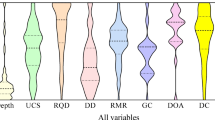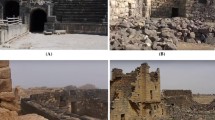Abstract
Accurately assessing the mechanical behavior of jointed rock mass is one of the most important requirements in the geotechnical and mining engineering projects, including site selection, design, and successful execution. The mechanical behavior of rock mass is significantly affected by the deformation modulus which can be influenced by several parameters. In this paper, a new radial basis function neural network (RBFNN) model was developed to predict deformation modulus based on dilatometer tests at the Bakhtiary dam site, Iran. The model inputs, mostly acquired from geotechnical bore holes, are overburden height (H), rock quality designation (RQD), unconfined compressive strength (UCS), bedding/joint inclination to core axis, joint roughness coefficient (JRC), and filling thickness of joints. High accuracy of prediction was examined by calculating indices such as the variance accounted for, root-mean-square error, mean absolute error, and the coefficient of efficiency. Sensitivity analysis has been conducted on the RBFNN results of Bakhtiary dam site. Based on the obtained results, UCS and RQD are the most effective parameters and inclination of rock joint/bedding to core axis is the least effective parameter in the deformation modulus of rock mass.













Similar content being viewed by others
References
Barton N (1978) Suggested methods for the quantitative description of discontinuities in rock masses: International Society for Rock Mechanics. Int J Rock Mech Min Sci Geomech Abstr 15(6):319–368
Barton N (2002) some new Q-value correlations to assist in site characterization and tunnel design. Int J Rock Mech Min Sci 39:185–216
Bhushan MV, Sitharam TG (2008) Prediction of elastic modulus of jointed rock mass using artificial neural networks. Geotech Geol Eng 26:443–452
Bieniawski ZT (1974) Geomechanics classification of rock masses and its application in tunneling. In: Proceedings of the third congress of the international society for rock mechanics. Denver: pp 23–32
Bieniawski ZT (1979) The geomechanics classification in rockengineering applications. In: Proceedings of the fourth congress of ISRM, vol 2, Montreux, pp 41–48
Bishop C.M. (1995) Neural Networks for Pattern Recognition. Oxford University Press, New York, pages 482: 165–171
BJVC (2009a) Bakhtiary Dam and HEPP, Engineering geology and rock mechanics report; Report No 4673/4049 Rev 1
BJVC (2009b) Bakhtiary Dam and HEPP, Geological Report, Report No. 4673/4038 Rev 1
Boyd RD (1993) Elastic properties of jointed rock masses with regard to their rock mass rating value. In: Cripps JC et al (eds) The engineering geology of weak rock. Balkema, Rotterdam, pp 329–336
Broomhead DS, Lowe D (1988) Multivariable functional interpolation and adaptive networks. Complex Systems 2:321–355
Cai M, Kaiser PK, Uno H, Tasaka Y, Minami M (2004) Estimation of rock mass deformation modulus and strength of jointed hard rock masses using the GSI system. Int J Rock Mech Min Sci 41:3–19
Ding L, Zhou C (2013) Development of web-based system for safety risk early warning in urban metro construction. Automat Constr 34:45–55
Fahimifar A, Soroush H (2003) Rock mechanics tests, theoretical aspects and standards. Vol. No 1, Published by soil mechanics Laboratory, Tehran
Franklin JA, Dusseault MB (1989) Rock engineering. McGraw-Hill, New York. José M
Ghasemi E, Amini H, Ataei M, Khalokakaei R (2014) Application of artificial intelligenc techniques for predicting the flyrock distance caused by blasting operation. Arab J Geosci 7:193–202
Goodman, Richard E. (1989) Introduction to rock mechanics. Second edition, John Wiley& Sons, New York
Gokceoglu C, Sonmez H, Kayabasi A (2003) Predicting the deformation moduli of rock masses. Int J Rock Mech Min Sci 40:701–710
Grima MA (2000) Neuro-fuzzy modelling in engineering geology. A.A. Balkema, Rotterdam
Guo H, Lin S, Liu J (2006) A radial basis function sliding mode controller for chaotic Lorenz system. Physics Letters A 351:257–261
Habibagahi G, Katebi S (1996) Rockmass classification using fuzzy sets. Iran J Sci Technol Trans B 20(3):273–284
Den Hartog MH, Babuska R, Deketh HJR, Grima MA, Verhoef PNW, Verbruggen HB (1997) Knowledge-based fuzzy model for performance prediction of a rock-cutting trencher. Int J Approx Reason 16(1):43–66
Ham F., Kostanic I. (2001) Principles of Neurocomputing for Science & Engineering. McGraw-Hill, New York
Hoek K (1983) Strength of jointed rock masses. Géotechnique J 23(3):187–223
Hoek E (1994) Strength of rock and rock masses. ISRM New J 2(2):4–16
Hoek E, Brown ET (1997) Practical estimates of rock mass strength. Int J Rock Mech Min Sci 40:701–710
Hoek E, Carranza-Torres C, Corkum B (2002) Hoek–Brown failure criterion-2002 edition. In: Proceedings of 5th North American Rock Mechanics Symposium and Tunneling Association of Canada Conference: NARMS-TAC pp 267–271
Hoek E, Kaiser PK, Bawden WF (1995) Support of underground excavations in hard rock. Balkema, Rotterdam, p 215
Hoek E, Diederichs MS (2006) Empirical estimation of rock mass modulus. Int J Rock Mech Min Sci 43:203–215
Interfels (2002) Dilatometer system, Boart Longyear interfels Gmbh, available at http://www.interfels.com
Jang RJS, Sun CT, Mizutani E (1997) Neuro-fuzzy and soft computing. Prentice-Hall, Upper Saddle River
Karami A, Afiuni-Zadeh S (2012) Sizing of rock fragmentation modeling due to bench blasting using adaptive neuro-fuzzy inference system and radial basis function. Int J Min Sci Technol 22:459–463
Kayabasi A, Gokceoglu C, Ercanoglu M (2003) Estimating the deformation modulus of rock masses: a comparative study. Int J Rock Mech Min Sci 40:55–63
Ladanyi B (1987) Suggested methods for deformability determination using a flexible dilatometer. Int J Rock Mech Min Sci 24(2):123–134
Luo FL, Unbehauen R (1999) Applied neural networks for signal processing. Cambridge University Press, Cambridge
Majdi A, Beiki M (2010) Evolving neural network using a genetic algorithm for predicting the deformation modulus of rock masses. Int J Rock Mech Min Sci 47:246–53
Mitri HS, Edrissi R, Henning J (1994) Finite element modeling of cable-bolted slopes in hard rock ground mines. Presented at the SME annual meeting. Albuquerque, New Mexico, In, pp 94–116
Moosavi M, Yazdanpanah MJ, Doostmohammadi R (2006) Modelling the cyclic swelling pressure of mudrock using artificial neural networks. Eng Geol 87:178–94
Motiei H (1993) Geology of Iran, stratigraphy of Zagros. Geological Survey of Iran publication—Tehran, Iran, In Persian
Narendra BS, Sivapullaiah PV, Suresh SN, Omkar SN (2006) Prediction of unconfined compressive strength of soft grounds using computational intelligence techniques: a comparative study. Comput Geotech 33:196–208
Palmström A, Singh R (2001) The deformation modulus of rock masses—comparisons between in situ tests and indirect esti-mates. Tunnel Undergr Space Technol 16:115–131
Rojas R (1996) Neural networks: a systematic introduction. Springer Verlag, Berlin
Ross T (1995) Fuzzy logic with engineering applications. McGraw-Hill Inc., New York
Serafim JL, Pereira JP (1983) Considerations on the geomechanical classification of Beniawski: experience from case histories. Proceedings of symposium on engineering geology and under-ground openings, Lisbon, In, pp 1133–1144
Sridevi J, Sitharam TG (2003) Characterization of strength and deformation of jointed Rock Mass based on statistical analysis. Int Journal Geomech 3.1:43–54
Sonmez H, Ulusay R (1999) Modifications to the geological strength index (GSI) and their applicability to stability of slopes. Int J Rock Mech Min Sci 36:743–760
Sonmez H, Gokceoglu C, Ulusay R (2004) indirect determination of the modulus of deformation of rock masses based on GSI system. Int J Rock Mech Min Sci 41:849–857 equation. Int J Rock Mech Min Sci 43:224–235
Tan Y, Zhang Z (2011) A RBF neural network approach for fitting creep curve of sandstone. Adv Mater Res Vols 171–172:274–277
Verman M, Singh B, Viladkar MN, Jethwa JL (1997) Effect of tunnel depth on modulus of deformation of rock mass. Rock Mech Rock Eng 30(3):121–127
Yilmaz I, Kaynar O (2011) Multiple Regression, ANN (RBF, MLP) and ANFIS models for prediction of swell potential of clayey soils. Expert Syst Appl 38:5958–5966
Yow JL Jr (1993) Borehole dilatometer testing for rock engineering. Comprehensive rock engineering principles, practice and projects, Vol. 3. Pergamon Press, Oxford, pp 671–682
Zhang L, Einstein HH (2004) Using RQD to estimate the deformation modulus of rock masses. Int J Rock Mech Min Sci 41:337–341
Zhouquan L, Hongyan Z, Nan J, Yiwei W (2013) Instability identification on large scale underground mined-out area in the metal mine based on the improved FRBFNN. Int J Min Sci Technol 23:821–826
Acknowledgments
The authors would like to appreciate Stucky Pars Engineering Co. and Moshanir Consulting Engineers Co. as well as Iran Water & Power Resources Development Co. for their effective cooperation in providing Bakhtiary dam test data.
Author information
Authors and Affiliations
Corresponding author
Rights and permissions
About this article
Cite this article
Asadizadeh, M., Hossaini, M.F. Predicting rock mass deformation modulus by artificial intelligence approach based on dilatometer tests. Arab J Geosci 9, 96 (2016). https://doi.org/10.1007/s12517-015-2189-5
Received:
Accepted:
Published:
DOI: https://doi.org/10.1007/s12517-015-2189-5




